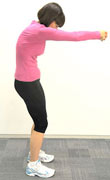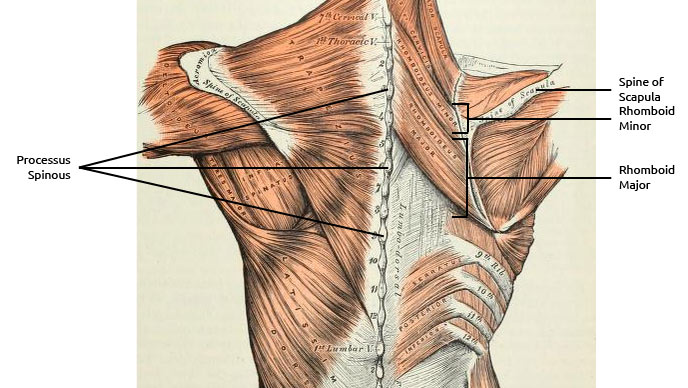The goal of today’s article is to help you learn more about the anatomy of the rhomboids, the origin and the cause of the pain, how to accurately diagnose it, and offer some practical exercises you can follow to help yourself.
Rhomboid strain is a term used loosely to describe a stretch or a tear in the muscles. Another common condition involving these muscles is known as rhomboid spasm – this is a sudden, involuntary tightening of the muscle which may result in muscle knots.
The rhomboid muscles are a deep set of muscles of the upper back. They connect the medial edge of the shoulder blade to the spine.
Rhomboid Muscles – Location, Attachments and Function
First of all, notice we said “muscles” instead of “muscle”; many people make the same mistake not knowing that there are two rhomboid muscles in our back:
- Rhomboid major (large) and
- Rhomboid minor (small)
Rhomboid Major
Rhomboid major arises from the spinous processes of the second, third, fourth and fifth thoracic vertebrae (Spinous process is a bony projection off the back of the vertebra, it can be felt under the skin 1) and attaches to the triangular surface at the root of the spine of the scapula (scapular spine is a bony prominence which divides the back surface of the shoulder blade into two portions).
Rhomboid Minor
Rhomboid minor arises from the spinous processes of the seventh cervical, first thoracic vertebra and lower part of the nuchal ligament (ligament located at the back of the neck formed of supraspinosus ligaments) and attaches to the triangular surface of the scapular spine.
Muscles Functions: the main functions of these muscles are:
- To stabilize the scapula and hold it onto the rib cage
- Retract the scapula – pull it towards the spine, and
- Elevate medial border of the scapula
Rhomboid muscle strain is an injury in which muscle fibers are torn or overstretched. A muscle can also go into spasm – an involuntary contraction, which may result in knots. This strain will not only cause upper back pain, it can also limit shoulder and neck mobility.
Rhomboid strain is most commonly caused by shoulder and arm overuse. Activities which are known to cause this muscle strain are:
- Lifting your arm above your head – serving in tennis of stacking things on higher shelves for instance
- Carrying a heavy backpack – carrying a heavy backpack can cause rhomboid strains and spasms but it can also promote poor posture (if the backpack is too heavy or if it is worn over one shoulder)
- Rowing – either in the gym or participating in the sport
- Poor posture – poor posture (sitting at your desk or at your PC) will may weaken your muscles, put additional strain to them and lead to back pain. You can find out more about posture here – Good Posture Can Change Your Life
- Lifting things off the ground – when lifting (heavier) things off the ground, you should always use your legs rather than your back. Intense, sudden lifting can pull the muscles of the back and cause strains and injuries
Diagnosis
Your healthcare provider will first take your medical history, specifically asking about any similar shoulder or upper back injuries, and any potential co-existing diseases that could affect or be responsible for your pain. You will also be asked to provide more information regarding the circumstances of the injury – when did you first experience pain, are there any other symptoms, what activity you were involved in when you injured yourself or if you play sports.
Then comes physical examination (palpation) of your shoulders, upper back and area around the inner edge of the scapula. The doctor will also ask you to move your arm to determine the range of motion and the extent of the injury.
The most common symptoms of rhomboid strain are:
- Pain between shoulder blades – this pain is usually felt between shoulder blades and the spine (since this is where the muscle is located); it can get worse when moving your arms
- Pain when taking deep breaths
- Palpable muscle knots
- Tenderness in the upper back area
Since these injuries are usually not severe, they are treated non-surgically: treatment usually involves a combination of exercises, stretches and over-the-counter medication (to ease intense pain). If the injury is less severe, recovery process might take only a couple weeks, but if the damage to the muscles is severe, it may take up to 6 weeks or even longer.
Home Treatment
To shorten the recovery process, it is advised to start treating rhomboid spasms as soon as they occur. You can relieve pain and swelling with:
- Ice packs – you can use ice packs, crushed ice, gel pack or even some frozen foods, wrap it in a cloth (to avoid direct skin contact) and hold for 20-30 minutes. You should repeat this process every 3-4 hours, in the first couple days
- NSAIDs – your healthcare provider will usually recommend nonsteroidal anti-inflammatory medication to help with the pain and inflammation; most common ones are: ibuprofen or aspirin. Make sure you use correct dosage the doctor specified and take them with food since they may damage the lining of your stomach
- Heat – heat is is good for relaxing tense muscles and breaking those tight muscle knots. You can place warmed towels on your back or opt-in for a heating pad. NOTE: do not apply heat if you notice swelling, heat is not usually helpful with infections, only muscle spasms
- Self-massage – massaging yourself is tricky enough but when it comes to upper back, it is close to impossible. But you can use a tennis ball: place your ball on the floor and lie over it so that it presses the muscles of your upper back; then roll the ball gently over the tense muscles of your back. Alternatively, you can buy a back massager for breaking up knots in your back. One of the best ones on the market today is Body Back Buddy Trigger Point Massager! You can find out more about this weird looking device on Amazon.com if you Click Here
Stretches and Exercises
Before engaging in any stretches and exercises for rhomboid strain relief, you should consult your doctor. You need to determine your capabilities, severity of the injury and the best exercises for your specific condition. After that, you can employ the ones we outlined below:
 Upper Back Stretch:
Upper Back Stretch:
- Stretch your arms in front of your body and clasp them together
- Reach forward and bend your head
- Feel the stretch in your upper back and neck and hold it for up to 30 seconds
- Repeat up to 5 times
Variation: if you want a “more intense” stretch, instead of just extending your arms, grab onto something and lean back.
Neck Side Stretches:
- Stand in a neutral position, facing forward
- Tilt your head to the side (towards your shoulder)
- Hold the stretch for up to 30 seconds, repeat up to 5 times on each side
 Side Arm Stretch:
Side Arm Stretch:
- Raise your left arm (shoulder height) and bring it to the opposite side of the body
- Raise your right arm and bend it across the left and pull
- Hold the stretch for up to 30 seconds and repeat 3-5 times with each hand
Kneeling back Stretch
- Kneel down and bring your body to the floor
- Extend your arms in front of you
- Reach forward as much as you can and stretch your upper back
- Hold for up to 30 seconds, repeat 3-5 times

Range of Motion Exercises
- Stand in a neutral position, your arms at the side of your body
- Lift your shoulders up and hold for about 5 seconds
- Squeeze your shoulder blades and hold for 5 seconds
- Pull your shoulder blades down and relax
- Repeat 5-10 times
Door Frame Stretching
- Stand parallel to the door frame
- Reach the right side of the frame with your left arm
- Lean to the left and feel the stretch
- Hold for up to 30 seconds and repeat a few times with each hand
References:
NOTE: HelpYourBack.org is a participant in the Amazon Services LLC Associates Program, an affiliate advertising program designed to provide a means for sites to earn advertising fees by advertising and linking to amazon.com.
[lastupdated]



